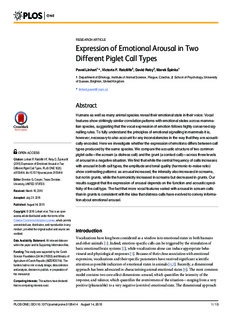
Expression of Emotional Arousal in Two Different Piglet Call Types PDF
Preview Expression of Emotional Arousal in Two Different Piglet Call Types
RESEARCHARTICLE Expression of Emotional Arousal in Two Different Piglet Call Types PavelLinhart1*,VictoriaF.Ratcliffe2,DavidReby2,MarekŠpinka1 1 DepartmentofEthology,InstituteofAnimalScience,Prague,Czechia,2 SchoolofPsychology,University ofSussex,Brighton,UnitedKingdom * [email protected] Abstract Humansaswellasmanyanimalspeciesrevealtheiremotionalstateintheirvoice.Vocal featuresshowstrikinglysimilarcorrelationpatternswithemotionalstatesacrossmamma- lianspecies,suggestingthatthevocalexpressionofemotionfollowshighlyconservedsig- nallingrules.Tofullyunderstandtheprinciplesofemotionalsignallinginmammalsitis, however,necessarytoalsoaccountforanyinconsistenciesinthewaythattheyareacousti- callyencoded.Hereweinvestigatewhethertheexpressionofemotionsdiffersbetweencall typesproducedbythesamespecies.Wecomparetheacousticstructureoftwocommon OPENACCESS pigletcalls—thescream(adistresscall)andthegrunt(acontactcall)—acrossthreelevels Citation:LinhartP,RatcliffeVF,RebyD,ŠpinkaM ofarousalinanegativesituation.Wefindthatwhilethecentralfrequencyofcallsincreases (2015)ExpressionofEmotionalArousalinTwo witharousalinbothcalltypes,theamplitudeandtonalquality(harmonic-to-noiseratio) DifferentPigletCallTypes.PLoSONE10(8): e0135414.doi:10.1371/journal.pone.0135414 showcontrastingpatterns:asarousalincreased,theintensityalsoincreasedinscreams, butnotingrunts,whiletheharmonicityincreasedinscreamsbutdecreasedingrunts.Our Editor:BrentonG.Cooper,TexasChristian University,UNITEDSTATES resultssuggestthattheexpressionofarousaldependsonthefunctionandacousticspeci- ficityofthecalltype.Thefactthatmorevocalfeaturesvariedwitharousalinscreamcalls Received:March19,2015 thaningruntsisconsistentwiththeideathatdistresscallshaveevolvedtoconveyinforma- Accepted:July21,2015 tionaboutemotionalarousal. Published:August14,2015 Copyright:©2015Linhartetal.Thisisanopen accessarticledistributedunderthetermsofthe CreativeCommonsAttributionLicense,whichpermits unrestricteduse,distribution,andreproductioninany medium,providedtheoriginalauthorandsourceare Introduction credited. Vocalizationshavelongbeenconsideredasawindowintoemotionalstatesinbothhumans DataAvailabilityStatement:Allrelevantdataare andotheranimals[1].Indeed,emotion-specificcallscanbetriggeredbythestimulationof withinthepaperanditsSupportingInformationfiles. basicemotionalbrainsystems[2],whilevocalizationsalonecaninduceappropriatebeha- Funding:ThisstudywassupportedbytheCzech viouralandphysiologicalresponses[3].Becauseoftheircloseassociationwithemotional ScienceFoundation(GA14-27925S)andMinistryof expression,vocalizationsandtheirspecificparametershavereceivedsignificantscientific AgricultureofCzechRepublic(MZERO0714).The attentionaspossibleindicatorsofemotionalstatesinanimals[4,5].Recently,adimensional fundershadnoroleinstudydesign,datacollection andanalysis,decisiontopublish,orpreparationof approachhasbeenadvocatedincharacterisinganimalemotionalstates[6].Themostcommon themanuscript. modelcontainstwocoreaffectdimensions:arousal,whichquantifiestheintensityofthe response,andvalence,whichquantifiestheaversivenessofthesituation—rangingfromavery CompetingInterests:Theauthorshavedeclared thatnocompetinginterestsexist. positive(pleasurable)toaverynegative(aversive)emotionalstate.Thedimensionalapproach PLOSONE|DOI:10.1371/journal.pone.0135414 August14,2015 1/13 ExpressionofEmotionalArousalinTwoDifferentPigletCallTypes providesaframeworkinwhichthesignallingofemotionalstatescanbeeasilycomparedacross differentspecies. Whenanimalsareexposedtodifferentemotionallyloadedsituations,theacousticfeatures oftheircallsvarywiththeassumedemotionalvalenceand/oremotionalarousal[4].Particu- larly,thepatternofchangesofcertainvocalfeaturesalongthearousalgradationissurprisingly uniformamongspecies(forexamplebothpitchandamplitudeincreasewitharousal),suggest- ingcommonunderlyingmechanisms[4,5].Thisremarkableconsistencyislikelyduetothe factthattheprinciplesofvocalproduction[7,8]andperception[9,10]areconservativein mammalianspecies.Interestinglyhowever,therearesomecallparameters,suchascalldura- tionortonality,thatdonotshowsuchaconsistencyacrossanimalspecies[4]. Oneaspectofemotionalsignallingwhichhasnotyetbeenconsideredisthatemotional statesmaybeencodeddifferentlyacrosscalltypeswithintherepertoireofthesamespecies. Whilecalltypeswithqualitativelydifferentacousticstructuresorfunctions,suchasalarmcalls (e.g.[11]),contactcalls(e.g.[12]),ornon-situation-specificcallslikedogbarks[13]orpig grunts(e.g.[14])haveallbeeninvestigated(reviewedby[4,5]),distresscallshavereceiveddis- proportionatelygreaterscrutiny(e.g.[15,16,17]),perhapsbecauseanimalsvocalizemoreread- ilyandconspicuouslywhentheyexperiencestress.However,becausecalltypesaredefinedby overalldifferencesintheiracousticstructure,assumedtoreflectspecificfunctions[18],varia- tioninemotionalstatemaybeencodedindifferentwaysacrosscalltypes. Emotionsinducechangesintheautonomicnervoussystem.Changesinemotionalarousal triggermodificationsinphysiologicalprocessessuchasrespiration,muscletensionandsaliva- tion[19,20].Becausetheseprocessesaredirectlyinvolvedinvocalproduction,acousticparam- etersthatarecontrolledbytheseprocessesshouldvaryconsistentlywiththeemotionalstateof thesignallerindependentlyfromtheparticularcalltypeproduced.Forinstance,emotionally drivenvariationinrespiratoryairflowmaysimilarlymodulatetheamplitudeofvocalisations acrosscalltypes.Thus,anycalltypemightreflecttheemotionalstateoftheanimalindepen- dentlyofitsfunctionorspecificstructure[14].However,fewstudieshavereportedhowdiffer- entcalltypesmayencodethesameemotionalstateinmammals[14,21]. Wetestedthehypothesisthatacousticparameterswithintwofunctionallyandstructurally differentcalltypeswouldchangeinasimilarwaywithincreasingemotionalarousalindomestic pigletvocalisations.Pigletsemittwobasiccalltypes(Fig1).Highfrequencycalls(screamsand squeals)aremainlygiveninsituationsofurgentthreat.Incontrastlowfrequencycalls(grunts) arenotsituation-specificastheyareproducedacrossawiderangeofnon-emergencysocialsitu- ationsaswellasurgentdistresssituations[22].Thesignallingfunctionofgruntsindistresscon- textsremainsunclear,butassocialcallsitispossiblethattheycouldfacilitateindividual recognition.Althoughtransitionalvocalisationsaresometimesproduced,screamsandgrunts representwellseparatedcalltypes[22,23].Inadditiontotheirfunctionaldifferences,theproduc- tionofbothcallsalsodiffers:gruntsareemittednasallywhilescreamsareemittedorally,though bothareassumedtooriginatefromthevocalfolds[24].Thestructureofscreamcallshasalready beenshowntoreflectarousalinpiglets(e.g.[16]),whilepotentialassociationsbetweengruntcall structureandtheemotionalstateofthesignallerremainlargelyunexplored(butsee[14,16]). Inthecurrentstudy,wedirectlycomparetheacousticstructureofpigletscreamsandgrunts emittedinthesameemotionalandphysiologicalcontexts.Tocontrolforpotentialdifferences inemotionalstatebetweenindividuals,wecomparescreamandgruntcallsthatwereemitted inimmediatesuccessionacrossthreebroadlevelsofarousal,ensuringthatthetwovocalisa- tionswereproducedwhenthepigletwasinanequivalentphysiologicalstate.Asthepurposeof thisstudyistodemonstrategeneralprinciples,ratherthantodeterminespecificindicatorsof particularemotionalstates,wefocusonasmallnumberofcommonlyinvestigatedacoustic parameters:duration,amplitude,centralfrequencyandharmonic-to-noiseratio.Inaccordance PLOSONE|DOI:10.1371/journal.pone.0135414 August14,2015 2/13 ExpressionofEmotionalArousalinTwoDifferentPigletCallTypes Fig1.Typicalscreamandgruntcallsandthecourseofthebacktestsession,depictingthecallingactivity(spectrogramandoscillogram), strugglingpresence,andstrugglingforceover60softhebacktestonasecondbysecondbasis. doi:10.1371/journal.pone.0135414.g001 withpreviousresearch,weexpectthatbothgruntsandscreamsshouldbelonger,moreintense, harsher(lowerharmonic-to-noiseratio)andhavemoreenergyinhigherfrequencieswith increasingarousal. Methods Ethicsstatement TheexperimentwasapprovedbytheInstitutionalAnimalCareandUseCommitteeofthe InstituteofAnimalScienceandtheCzechCentralCommitteeforProtectionofAnimals,Min- istryofAgriculture(decisionMZe1244).Thisstudywasapartoflargerprojectinvestigating theconsistencyofarousalsignallingacrossdifferentcontextsandsituations.Forthisreason, werecordedpigletsinanumberofpositiveandnegativenaturalandexperimentalsituations withdifferentlevelsofarousal.Thebacktestsituation(commonlyusedinpigstostudyindivid- ualcopingstyles[25,26,27])correspondstoamildlystressfulsituationcausedbytheseparation ofthepigletfromitslitterandbeingplacedinanunnaturalposition.Thestressinducedbythe backtestisconsideredmildandisnotprolonged(thewholeprocedure,includinghandling, lastsabout3minutes).Allofthepigletswerehealthywhentheywerereturnedtotheirhome penimmediatelyafterthetest.Pigletswerecarefullyandgentlyhandledandtransportedina straw-beddedcratetoreducestress.Nopainrelieverswerenecessary. Animals Piglets(LargeWhite×Landrace)werebornandkeptattheexperimentalfarmoftheInstitute ofAnimalScience,Prague,Czechia.Sowsandpigletswerehousedin2.3mx2mstraw-bedded, PLOSONE|DOI:10.1371/journal.pone.0135414 August14,2015 3/13 ExpressionofEmotionalArousalinTwoDifferentPigletCallTypes concretefloorpensequippedwitha‘walkaround’ellipsoidfarrowingcrate(2.3mx1.4m). Sowswerefedastandardlactationdiettwiceaday.Waterwasavailableadlibitumseparately forthesowandforthepiglets.Pigletswereweighedandindividuallymarkedatday1postpar- tum(bodymarker).Weaimedtotesteightpigletsperlitter.Overall,12littersweresubjected tobacktest.In3litters,wecouldonlytest6,6,and4pigletsperlitterduetosmalllittersizeor verylowweight(<1.00kg)leadingto88pigletswithintermediateweights(mean+-sd=1.84 kg+-0.44kg;range:1.04kg–2.80kg)beingsubjectedtobacktest.Thenumberofmaleand femalepigletswasbalanced(44males/44females). Eachlitterwastestedwithinasinglepausebetweennursingepisodesstarting5minutes afternursingended.Pigletsweretestedinarandomizedorder.Eachpigletwasgentlyremoved fromthelitterandtransported(c.a.30s)inastraw-beddedbaskettoaseparatetestingroom wherethebacktestwasperformed.Ingeneral,pigletsremainedcalmandsilentduringpen removalandtransportation.Thewholeproceduretookabout3minutes. Backtest Weusedthebacktestasamodelsituation,whichiscommonlyusedinpigstostudyindividual copingstyles.Forthepurposeofthisstudy,wewerenotinterestedincopingstylesofpiglets butinsteadfocusedonbehaviourofthepigletsduringthebacktest.Weadaptedtheprocedure fromHessingetal.[27]andRuisetal.[26].Thepigletwasgentlyputonitsbackonadigital scaleandkeptinthispositionfor60sbyplacingonehandoverthepiglet’sthoraxandholding itsrightforelegwiththeotherhand.Thehindlegsremainedfreetomove.Thesmallestforce possiblewasusedtokeepthepigletinthesupinepositiontoensurethattheweightreadingson thescalematchedthestrugglingforceofthepigletascloselyaspossible.Oneperson(PL)per- formedallofthetesting.Althoughthescalereadingsareonlyapproximationsofthestruggling force,theyallowedustounambiguouslydifferentiateperiodsofmoreversuslessintensestrug- gling.Werecordedthenumber,latencyanddurationofstrugglingperiods.Onestrugglewas definedasacontinuousseriesofwriggles.Subsequentstruggleshadtobeseparatedatleastby 1sofresttobetreatedastwoseparatestruggles.Thewholeprocedurewasvideotaped.We notedwhetherthepigletwasstrugglingornotonasecond-by-secondbasis.Wealsoidentified themomentwhenthepigletwasstrugglingwiththemaximumintensity(astheabsolutemaxi- mumweightonthescale). Threelevelsofarousal Previousstudieshaveuseddifferentapproachestoinduceandassessemotionalarousalinani- mals,including,forinstance,presentingmoreandlessdangerouspredators,avoidance/pref- erenceforthesituation,administrationofpsychoactivedrugs,aswellasusingtheintensityof thebehaviouralandphysiologicalresponsetosituationorstimulus[4,5].Inthepresentstudy, weusethestrugglingofpigletsasabehaviouralindicatoroftheiremotionalarousal.Thebackt- estrepresentsanegatively-valenced,stressfulsituationleadingtoanincreaseincortisollevels inpiglets[28].Piglet'sstrugglingtoescapecanbeviewedasabehaviouractivatedbythepun- ishmentavoidancesystem[6].Theresponsesofpigletstothebacktestvaryfromtonicimmo- bility,lyingstillbutalerted,tofiercestruggling.Theselevelscorrespondwellwiththe descriptionofarousalbyRussel[29]:“Theverticaldimension,arousal,rangesfromsleep,then drowsiness,throughvariousstagesofalertnesstofreneticexcitement.Thefeelingisone’ssense ofmobilizationandenergy.”Althoughweuseonlybehaviouralindicatorsofarousal,itisvery likelythatthefrequentlyusedphysiologicalindicatorsofarousalsuchasheartrateandrespira- tionrate(seee.g.[30])wouldreflectstrugglingintensityaswell.Wethereforeconsiderstrug- glingasagoodindicatorofarousalinthebacktestsituation. PLOSONE|DOI:10.1371/journal.pone.0135414 August14,2015 4/13 ExpressionofEmotionalArousalinTwoDifferentPigletCallTypes Foreachpiglet,weidentifiedthreebroadarousallevelsduringthebacktestbasedonqualita- tiveandquantitativebehaviouralindicators.Thebacktestsituationisassumedtobeexperi- encedasnegativeandunpleasant,yetnotpainful,bypiglets.Thebehaviourofpigletsduring thetestvariedmarkedlyfromlyingstill(=noorlittlemuscleactivation)tointensestruggling, indicatingaprogressiveactivationofthepunishmentavoidancesystem[6].Weidentified threedistinctarousallevels:1)Lowarousallevel(LOW):thepigletliesstillonthescalewithout struggling,thepigletresiststhesituationpassively;2)mediumarousallevel(MEDIUM):the pigletshowsactiveresistanceandstrugglestoescapewiththelowtoveryhighresistanceforce (wetooktheweightnecessarytokeeppigletinasupinepositionasaproxyfortheresistance intensity);3)maximumsituationarousallevel(MAXIMUM):thepigletshowsthemostinten- siveactiveresistancewhilststruggling(maximumweightnecessarytokeeppigletinasupine positionduringthebacktest). Audiorecordingandanalyses Adirectionalmicrophone(SennheiserME66,flatresponse40–20000Hz,maximumsound pressurelevel=128dBSPL)equippedwithafoamwindshieldwasplaced1.5mabovethepig- letduringthetrial.VocalizationswererecordedonadigitalsolidstaterecorderMarantz PMD671intoa24-bit,48000Hz,mono,PCM(wav)format.Therecordingvolumegainwas keptconstantovertherecordings.Tomeasurethesoundpressurelevel,therecordingswere calibratedwithareferencebeepsoundwhosesoundlevelwasmeasuredatthemicrophone withalso-TechSLM-1352ASoundlevelmeter(fast,A-weighting).Pigletswereabletomove theirheadsfreely,thereforetheheadwasnotalwaysdirectlypointinginthedirectionofthe microphone,whichcouldhaveaffectedthemeasurementsofthesoundpressurelevel.Never- theless,headmovementsoccurredinallstagesoftestandhencethisvariationwasunlikelyto causeanysystematicbiasinourresults.RecordingswereanalysedinAvisoftSASLabPro[31]. Allcallswereidentifiedautomaticallyinthefirststage(-15to-20dBthresholdsforcallonset andoffsetdependingontherecording).Annotatedrecordingswerethenreviewedmanually andanymisclassificationswerecorrected(c.a.1–5%;non-detectedcalls,partlydetectedcalls– incorrectonsetsoroffsets,mergedcalls,etc.). Weselected6callsperpiglet:3screamcalls(highfrequencycalls)and3gruntcalls(lowfre- quencycalls),withonecallperarousallevelforeachcalltype(Fig1).Weusedthepeakfre- quencyasacriteriontoclassifythecallasagruntorascreaminaccordancewithprevious studies[23].Becausethedistributionofpeakfrequencyvalueswasclearlybi-modal,callswith apeakfrequencyabove1000Hzwereclassifiedasscreams,whilsttheremainingcallswere classifiedasgrunts.Screamcallswerealwaysselectedfirstforeacharousallevel.TheMAXI- MUMscreamcallwasthecallemittedinthetimeofthemostintensivestrugglingresistance +/-onecall.TheMAXIMUMgruntcallwasthecallimmediatelyneighbouringtheMAXI- MUMscreamoragruntcallproducedamaximumof1sfromonsetoroffsetofthescream. BecausetheMEDIUMarousallevellastedaconsiderableamountoftimeandthereweretypi- callymanyMEDIUMscreamcallswithinatrial,weselectedonescreamatrandomandpaired itwithaMEDIUMgruntwithin2sfromtheMEDIUMscreamcall.Thesameselection approachwasusedinthecaseoftheLOWscreamandgruntcalls.Asaresultofthisselection processweobtainedthreepairsofscreamandgruntcallsperpiglet.Wedidnotanalysemore thanonecallfromeacharousallevelasthebehaviourofthepigsvariedrapidlyduringthetest, forexample,theintensityofstrugglingchangedveryquicklyintheMEDIUMarousallevel, whilstcallsinLOWarousallevelwereinfluencedbytheirtemporalproximitytostruggling bouts.Therefore,comparisonsbasedonaverageswouldnotsuitthepurposeofourstudy. Withineachscream/gruntpairwecouldbesurethatthetwocallswereemittedinavery PLOSONE|DOI:10.1371/journal.pone.0135414 August14,2015 5/13 ExpressionofEmotionalArousalinTwoDifferentPigletCallTypes similarphysiological(heartrate,respirationrate,muscletension,etc.)andemotional/motiva- tionalstatewithouttheneedtomeasurethephysiologicalandemotionalstateofthepiglets directly.Finally,wehadafullsetof6callsfor30piglets,providing180analyzedcallsintotal forthemainanalysis.Fortherestofthepigletswewerenotabletogetacompletesetofgrunts andscreamsfromeacharousallevel. Wedecidedtofocusouranalyseson4acousticparametersofthecalls:duration(s);root- (cid:1) mean-squaresoundintensity(dBSPL);central frequency(Hz;frequencydividingtheaverage spectrumofthecallintwopartsofequalenergy;50%quartilefrequencyinAvisoftSASLab— usedasthespectrumdistributioncharacteristic),andtonality(dB,harmonic-to-noiseratio). Thesefourparameterscomprisesomeofthemoststudiedvocalparametersandhaveprevi- ouslybeenlinkedtospecificphysiologicalchanges[4].Wedidnotevaluatethefundamental frequency(F0)becauseitwasproblematictoobtaintheF0foralargeamountofthecalls (becausetheyweretoonoisyand/orshort)andwewantedtofocusonlyonthoseparameters thatwouldbeeasilycomparablebetweenthescreamandgruntcalltypes. Theduration,root-mean-squareamplitudeandcentralfrequencyweremeasuredautomati- callyinthedetectedcallswiththe‘Automaticparametermeasurement’toolinAvisoftSASLab. Thespectrogramsettingswere:FFTlength=1024,windowlength=0.046s,window type=Hamming.Thesoundintensitywascalibratedwithabeepofknownintensity(see above)atthebeginningoftherecordingbyusingthefunction‘Calibration/SPLwithreference sound’inAvisoftSASLab.Theharmonic-to-noiseratiowasmeasuredinPRAAT[32]using the‘ToHarmonicity(cc)’functionwiththestandardsettings(Timestep:0.01s;Minimum pitch:75Hz;Silencethreshold:0.1;Periodsperwindow:1.0).Thisfunctioncomputesacoustic periodicityonthebasisofacross-correlationmethodindependentlyofwhetherapitchcanbe determined[33]. Besidestheanalysesofacousticcallstructure,wewerealsointerestedinhowpigletsvocalize whentheywerestrugglingversuswhentheywerestill.Becausethedurationofeachbeha- viouralresponsedifferedperpiglet,wecomputedthecallingrates(grunts/s;screams/s)ineach stage(still/struggling)separately. Statisticalanalyses StatisticalanalyseswerecarriedoutinR.Wilcoxonsigned-ranktestswereusedtodetermine whethercallingratesincreasedbetweenthestrugglingandstillstagesofthebacktest.Forthe mainanalysisweusedcallsfrom30pigletsforwhomwehadcompletesampleofcalls(grunts andscreamsfromallthreelevelsofarousal,seealso‘Audiorecordingandanalyses’).Weused linearmixed-effectmodels(‘lme’functionfrom‘nlme’package)toassesstheeffectofthe arousalleveloneachofthevocalparametersseparately(arousallevelasfixedfactorwiththree levels:LOW,MEDIUM,andMAXIMUM).Thecentralfrequencyanddurationwerefirstlog transformedduetonon-normality.Wealsoincludedaninteractiontermbetweencalltypeand arousalleveltoestablishwhetheranyoftheacousticparametersresponddifferentlytochanges inarousaldependingonthecalltype.Wealsoaddedthefixedeffectsoftestingorder,piglet sex,andpigletweighttocontrolfortheirpotentialinfluenceonthecallstructure.Thetest orderwasincludedasacovariatebecauseitprovidedanindicationoftimeaftermilkintake (westartedtestingeachlitter5minutesafternursingandthetestingofeachpiglettookabout3 minutes)whichcouldaffecttheemotionalstateofpiglets[15].Litterandpigletidentitywere includedasrandomfactors(pigletnestedwithinlitter).Weusedabackwardsstepwisemethod toremovenon-significantfixedvariablesfromthemodelsuntilonlysignificanteffects remained.Testingorder,pigletsex,andpigletweightwereneversignificant,thereforewe reportonlythemodelsincludingthefixedeffectsofarousallevelandcalltype.Wechecked PLOSONE|DOI:10.1371/journal.pone.0135414 August14,2015 6/13 ExpressionofEmotionalArousalinTwoDifferentPigletCallTypes thatthedistributionofresidualswasapproximatelynormalanddidnotsystematicallyvary acrossthefittedvalues(withconstantvarianceandnotrends).Therewereminorissueswith theresidualvarianceinthecaseofcentralfrequency,suggestinglargervarianceinthescream callsthaningruntcalls.Wethereforeusedthe‘weights’argumentofthe‘lme’functionthat enablestheheteroscedasticityofthewithin-errorgrouptobemodelled(i.e.allowsdifferent variancesforeachfactorlevel)[34].Weusedthe‘ghlt’functionfrom‘multcomp’toperform post-hoctestswithinthefinallinearmixedmodels. Results Behaviourofthepigletsduringthebacktest ThebehaviourofthepigletsissummarizedinTable1.Pigletsstartedtostrugglefromthestart ofthebacktest(latencytostrugglewas4.3sonaverage),performedaround3boutsofstrug- glingduringthetest(2.7boutsofstrugglingonaverage),andstruggledforalmosthalfofthe time(25.0sonaverage).Pigletsalsovocalizedintensively.Onaverage,pigletsemitted mean±SD=50.3±21.6callsduringthebacktest;takingeachcalltypeseparately,therewere slightlymoregrunts(29.8onaverage)thanscreams,butthenumberofscreamswasalsohigh (20.5onaverage). Thecallingratewashigherwhenthepigletswerestrugglingforbothscreams(Wilcoxon signedranktest:N=87,Z=-8.03,r=-0.61,p<0.001)andgrunts(Wilcoxonsignedranktest: N=88,Z=-4.69,r=-0.35,p<0.001). Arousalandcallparameters Screamsdifferedfromgruntsinalloftheinvestigatedacousticparameters(allp<0.001,see theeffectofcallstypeinTable2fordetails).Thearousallevelsignificantlyaffectedtheinten- sityandcentralfrequencyofthecalls.Withincreasingarousal,callsbecamelouderandhigher. However,alloftheacousticparameterswerealsoinfluencedbytheinteractionbetweencall typeandarousallevel,suggestingthatthetwocalltypesrespondeddifferentlytochanging arousallevels(seeFig2),whichwasconfirmedbypost-hoctests(S1Table). Thecalldurationdidnotsignificantlydifferbetweenthearousallevelsforeitherofthetwo calltypes(S1Table,allp>0.19).Thesignificantarousal(cid:1)calltypeinteractionthusprobably Table1. Descriptivestatisticsforpigletbehaviourduringthebacktest. allpiglets(n=88) pigletsinanalysis(n=30) mean sd mean sd struggles(n) 2.71 1.15 2.9 1.12 strugglingduration(s) 24.88 12.58 23.07 11.7 latencytostruggle(s) 4.3 9.2 3.1 4.3 pigletweight(g) 1830 450 1870 430 maximumresistanceforce(maximumweight/pigletweight) 1.46 0.16 1.47 0.18 vocalizations(n) 50.3 21.6 56.7 20.1 screams(n) 20.5 18.6 21.9 16.8 grunts(n) 29.8 15.1 34.8 12.9 screams/s—relaxed 0.10 0.17 0.09 0.12 screams/s–struggling 0.67 0.43 0.76 0.32 grunts/s–relaxed 0.35 0.29 0.51 0.32 grunts/sstruggling 0.81 0.61 0.78 0.45 doi:10.1371/journal.pone.0135414.t001 PLOSONE|DOI:10.1371/journal.pone.0135414 August14,2015 7/13 ExpressionofEmotionalArousalinTwoDifferentPigletCallTypes Table2. Effectsofcalltype(scream/grunt),arousallevel(LOW/MEDIUM/MAXIMUM)andtheirinteractiononthefouracousticparameters. Variable effect df F p Duration(log) calltype 1,145 99.18 <0.001 arousal 2,145 0.95 0.389 calltype*arousal 2,145 3.29 0.040 Root-mean-squareamplitude calltype 1,145 100.00 <0.001 arousal 2,145 28.18 <0.001 calltype*arousal 2,145 8.82 <0.001 Centralfrequency(log) calltype 1,145 772.67 <0.001 arousal 2,145 13.27 <0.001 calltype*arousal 2,145 5.29 0.006 Harmonic-to-noiseratio calltype 1,145 13.29 <0.001 arousal 2,145 2.04 0.134 calltype*arousal 2,145 15.48 <0.001 doi:10.1371/journal.pone.0135414.t002 arosefromtheslight,non-significantextensionofthescreamsandshorteningofthegrunts withincreasingarousal. Theintensityincreasedwitharousalonlyinthescreamcalls(S1Table,forgruntcallsall p>0.18);LOWscreamswerelessintensethaneitherMEDIUM(z=-6.43,p<0.001)or MAXIMUMscreams(z=-7.73,p<0.001). Thecentralfrequencyincreasedinboththescreamandgruntcalls(S1Table).Inscreams, theLOWarousalleveldifferedonlyfromtheMAXIMUMarousallevel(z=-3.64,p=0.002), whileingruntstheLOWarousalleveldifferedfromboththeMEDIUM(z=-3.85,p<0.001) andMAXIMUMarousallevels(z=-4.53,p<0.001).Thecentralfrequencyincreasedmuch moreinthegruntcallsthaninthescreamcalls. Theharmonic-to-noiseratioincreasedwitharousalinthescreamcalls(S1Table).LOW arousalscreamswerelessharmonicthanMAXIMUMarousalscreams(z=-3.02,p=0.020). Incontrast,theharmonicityofthegruntsdecreasedwitharousal,asbothMEDIUM(z=4.64, p<0.001)andMAXIMUM(z=4.10,p<0.001)gruntswerelessharmonicthantheLOW arousalgrunts. Discussion Inthisstudy,wetestedwhethertheacousticstructureofpigletdistresscallsandcontactcalls encodedcuestoemotionalarousal,andhowspecificacousticfeaturessignalthelevelofarousal acrossthetwocalltypes.Wefoundthatpigletsincreasethegruntandscreamratewhen aroused(i.e.strugglingduringbacktest).Increasedcallingratehasbeenoftenfoundtobeasso- ciatedwithincreasedarousal[4].Further,wefoundthattheacousticstructureofbothscreams (distresscalls)andgrunts(contactcalls)doesvarywitharousal.Thisisinagreementwithpre- viousstudiesofpigvocalizations[14,16]and,moregenerally,withtheoreticalandexperimen- talstudiesshowinghowemotionalstateaffectsthephysiologyofanorganism,whichisinturn reflectedinitsvocalizations[1,7,20].Suchphysiologicalchangesareassumedtoaffectthepro- ductionofalltypesofvocalizations,asdocumentedbythewiderangeofcontextsinwhich callshavebeenfoundtoreflectemotionalstate[4,5].Indeed,signallingsituationurgencypre- cedesthecontextualspecificityofcalls[35]. Althoughtheemotionalstatewassignalledinbothcalltypes,wefoundthatarousalwas encodeddifferentlyinscreamsandgrunts.Theeffectofsituationalarousalontheacoustic structureoftwocalltypesormorehavepreviouslybeenstudied,butcallparameterswere PLOSONE|DOI:10.1371/journal.pone.0135414 August14,2015 8/13 ExpressionofEmotionalArousalinTwoDifferentPigletCallTypes Fig2.Scream(emptycircles)andgrunt(fullcircles)parametersinthethreearousallevels.Meansand95%confidenceintervalsareshown.Duration andcentralfrequencyaredisplayedinlogarithmicscale.N=180(6callsfrom30individuals). doi:10.1371/journal.pone.0135414.g002 averagedeitherfromasubsetofcalls[36]orfromallofthecalls[14]withinthesameexperi- mentwithoutconsideringtheactualphysiologicalstateinwhichthecallswereemitted.Our studyisthefirsttodirectlycomparehowemotionalstateisencodedintwodifferentcalltypes underthesameconditions.Thephysiologicalconditionsonthevocalfolds(e.g.tension,sub- glottalpressure,etc.)andinthevocaltract(e.g.salivation)arelikelytheproximatefactors affectingexpressionofemotionsinvocalizations[4,8,20].However,theyaredifficulttocontrol andmeasureinliveanimals.Theadvantageofourstudywasthatweanalysedscreamsand gruntsemittedinclosesuccession(within2seconds)ineachsituation.Thefacteachscream andgruntpairwasemittedinclosesuccessionallowsustoconfidentlyassumethattheemo- tionalandphysiologicalstatewascomparableforbothcalltypes. Wefoundsignificantinteractionsbetweenarousallevelandcalltypeforallofthefour acousticparameters.Theseresultsindicatethatthefunctionand/orstructureofcalltypes affectstheacousticalencodingofemotions.Sucheffectscouldexplainwhystudiesinvestigat- ingvocalcorrelatesofemotionsinanimalsvocalisations[4,5]aswellasinhumanspeechor vocalisations[37]havefounddifferentandsometimescontradictingresults.Pigletgruntsare PLOSONE|DOI:10.1371/journal.pone.0135414 August14,2015 9/13 ExpressionofEmotionalArousalinTwoDifferentPigletCallTypes contactcallswithanacousticstructuresuitableforshort-rangecommunication(e.g.short durationandlowintensity),whilescreamsaredistresscalls'designed'tobeheard(withe.g.a longdurationandhighintensity).Wesuggestthatconstraintslinkedtotheproductionof thesetwocalltypes[24]causetheobserveddifferencesintheencodingofemotions. Neitherthedurationofthescreamsnorthedurationofthegruntswassignificantlyaffected byarousal.Despitethefactthattherelationshipbetweencalldurationandarousalhasreceived muchscrutiny,theresultshavebeencontradictory:increasingarousalhasbeenfoundtobe associatedwitheitheranincrease,adecrease,ornochangeincallduration[4,5].Increasedcall durationhelpsdetectionandlocalization[38],andconflictingresultsareparticularlyreported inalarmandisolationcontexts[5]whenfacilitatinglocalizationmaynotalwaysbebeneficial andmight,forinstance,attractunwantedattentionfrompredators.Hence,thecontextofcall emissionandwhetherthecallisdesignedtobeeasilydetectedornotcouldconstraintheway thatemotionalarousalisexpressedincallduration. Bothscreamsandgruntsincreasedincentralfrequencywithincreasingarousal.Thisisin accordancewiththegeneraltrendobservedacrossmammalianspeciesthatcallpitchincreases witharousal[4,5].Twoaspectsofvocalproductionarelikelytoaffectthepitchofscreamsand grunts.First,heightenedactivitywhenthepigletswerestrugglingtoescape(MEDIUMand MAXIMUMarousallevels)islikelytoresultinincreasedmuscletension,breathingrateand breathingamplitude,leadingtoanincreaseinthesubglottalpressureandhigherF0,which can,inturn,influencetheenergyspectrumincludingthecentralfrequency.Second,theneed foranincreasedairsupplyduringstrugglingmayresultinmorefrequentandgreatermouth opening,therebyraisingtheformantfrequencies[7,20].Wesuggestthatdifferencesinthepro- ductionofscreamsandgruntscouldexplainwhytherateofincreaseishigherforgrunts.Loud callssuchasscreamsaretypicallyemittedorallywithanopenmouth[24].Althoughgruntsare typicallyemittednasallywithaclosedmouthinstatesoflowarousal[24],ourpigletsfre- quentlyopenedthemouthwhilstproducinggruntsinhighlevelsofarousal,thusconsiderably shorteningthelengthofthevocaltractandmodifyingitsresonanceproperties[24]. Highactivityconnectedwithintensebreathingduringstruggling(MEDIUMandHIGH arousallevels),causeshighersubglottalpressure[7,20],andshouldleadtoanincreaseinthe amplitudeofbothcalltypes.Increasingcallamplitudewitharousalhasbeenfoundacrossa widerangeofspeciesandcontexts[4].However,theamplitudeincreasedsignificantlyonlyfor screams,whiletheamplitudeofthegruntswasnotaffectedbyarousal.Thismaybeaconse- quenceofthefactthatgruntsarerelativelyfaintvocalizationsusedincloserangecommunica- tion,andthatbecausegruntsaretypicallyproducednasally,thisdoesnotallowfora substantialincreaseinamplitude.Anothercontributingfactorcouldbethatnasalcavities absorbmoreacousticenergythanoralcavities[24].Moreworkonthemechanismsofvocal productioninpigsisclearlyneededtoconfirmorrefutethesespeculations. Wealsofoundthattheharmonic-to-noiseratioshowedoppositechangesforscreamsand forgrunts–itincreasedwitharousalinscreamswhileitdecreasedingrunts.Previouslabora- torystudieshavedescribedtransitionstochaoticvibrationregimeswithincreasingsubglottal pressure[39,40].However,thisdoesnotseemtohappenwithpigletscreams.Inourstudy,the harmonicityofthescreamcallsactuallyincreased(i.e.chaoticvibrationsdecreased)with arousal,aspreviouslyobservedinscreamsemittedintheextremelypainfulsituationofuna- nesthetisedcastration[16].Increasedtonalityincallsgiveninmoreurgentsituationshasalso beendocumentedinothermammalspecies[11].Itispossiblethatcertaincalltypes,including pigletscreams,needsubstantialairflowbeforetheyattainoptimumphonation.Ithasindeed beensuggestedthat,inhumans,increasedjitter(=lowervoicetonality)couldbeassociated withbothhypotensionandhypertensionofthevocalfolds[20]. PLOSONE|DOI:10.1371/journal.pone.0135414 August14,2015 10/13
Description: